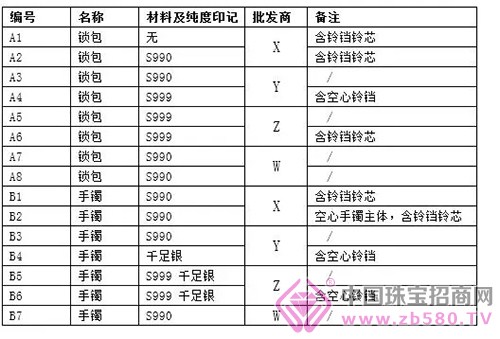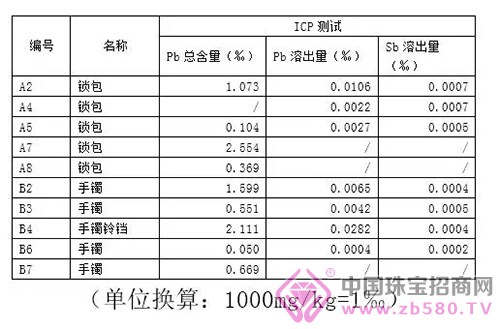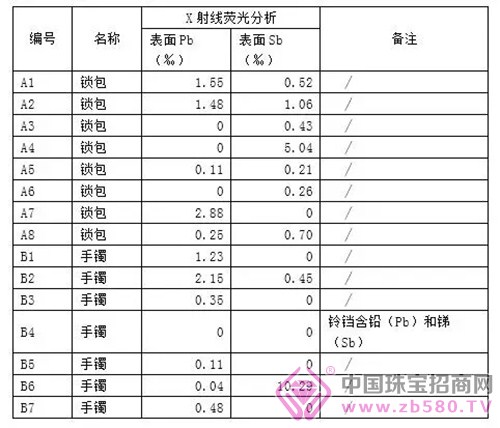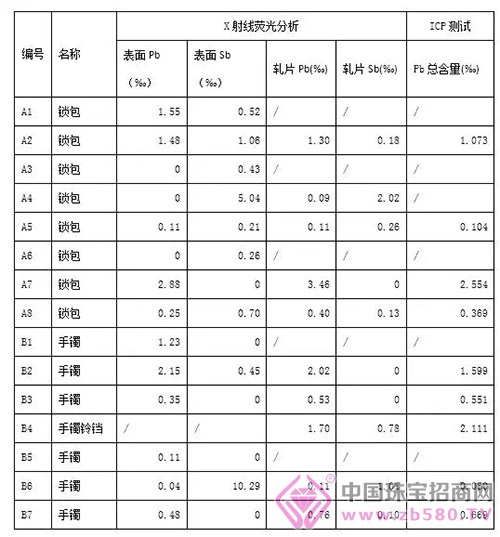Detection of harmful elements in children's silver jewelry
Abstract: Children's silver jewellery was purchased from Guangzhou wholesale market for harmful element detection. X-ray fluorescence spectroscopy was used to conduct preliminary screening of harmful elements, and ICP spectroscopy was used to test the total content and dissolution of harmful elements. Through testing, it is found that the harmful elements in children's silver jewellery are mainly lead (Pb) and bismuth (Sb). In particular, the total content of lead has a maximum limit exceeding the national mandatory standard "Regulations on the Limits of Harmful Elements in Jewelry". The situation is harmful to the physical and mental health of children. At the same time, through the test comparison, the screening results of X-ray fluorescence spectroscopy were satisfactory.
Key words: children's silver jewelry, harmful elements, X-ray fluorescence spectrometry, ICP spectroscopy, total content, dissolution
On May 1, 2013, the mandatory national standard GB28480-2012 "Regulations on the Limits of Harmful Elements in Jewelry" was officially implemented. The standard proposed the definition of children's jewelry, that is, children's jewelry [1] refers to jewelry for children under 14 years old. At the same time, the requirements for harmful elements in children's jewelry are higher than ordinary jewelry: the release of nickel from long-term contact with skin products is <0.5μg/(cm2.week), and the release of nickel from products with perforation of skin is <0.2μg/(cm2 .week), the maximum limit of mercury, arsenic and hexavalent chromium is 1000mg/kg, and the maximum limit of cadmium is 100mg/kg, which is consistent with the requirements of ordinary jewellery; the maximum limit of lead is increased by 1000mg/kg of ordinary jewelry. Up to 300mg/kg; at the same time increased the maximum dissolution of eight elements, they are: mg: 60mg / kg, arsenic: 25mg / kg, 钡: 1000mg / kg, cadmium: 75mg / kg, chromium: 60mg / kg Lead: 90mg/kg, mercury: 60mg/kg, selenium: 500mg/kg [1].
Why is the requirement for harmful elemental lead and the amount of harmful elements dissolved in children's jewelry? As a heavy metal element, lead is also a toxic metal [2]. It is difficult to discharge by itself after it is accumulated in the human body and can only be removed by drugs. When lead is accumulated to a certain amount, it can cause physical weakness, headache, sleep disorders, abdominal pain, joint and kidney damage, especially damage to the child's nervous system, leading to blood diseases and encephalopathy. After lead poisoning, children may develop stunting, decreased concentration, and mental retardation. Silver used to make silver jewellery is extracted from silver mines, which are usually symbiotic or associated with lead ore. In the process of purifying silver, lead is not completely removed, resulting in lead often in silver jewellery [3]. The requirement for the release of harmful elements in children's jewelry is because the child's self-control ability is not yet fully developed, and the things at hand are often stuffed into the mouth. Therefore, the amount of dissolution is measured by simulating the condition that the sample is continuously contacted with gastric acid for a period of time after swallowing to test the elution amount of some elements.
1 sample
In order to make a preliminary understanding of the harmful elements in the children's silver jewelry in Guangzhou market, the author went to the Guangzhou silver jewelry wholesale market and purchased bracelets suitable for children from several wholesalers (represented by the letters W, X, Y, Z respectively). And lock bag accessories for the detection of harmful elements. There are 15 test samples, including 8 lock accessories and 7 bracelet accessories, as shown in Figure 1 and Table 1.

Figure 1 Picture of the test sample
Table 1 Basic conditions of test samples

2 experimental methods
The preliminary screening of harmful elements was carried out by X-ray fluorescence spectrometry, and the total content and the amount of harmful elements were tested by ICP spectroscopy.
X-ray fluorescence spectroscopy was performed using Thermo Fisher's ALTQUANT'X fluorescence spectrometer with a resolution of manganese (Mn) at a peak of 5.89 keV with a resolution better than 155 eV.
The ICP spectroscopy test uses the Optima2000DV inductively coupled plasma emission spectrometer from American PE Company. The precision of the instrument is 1%, and the detection limit of the measured elements is better than 0.2mg/L.
3X-ray fluorescence spectrometry test and analysis
All samples were screened for harmful elements using an ALTQUANT'X fluorescence spectrometer and their content was initially estimated. During this test phase, the sample was not destroyed.
The first step is to screen the harmful elements in three conditions. The three conditions and the elements of the analysis are shown in Table 2. Under these three conditions, the test time exceeds 100s, and nickel (Ni), arsenic (As), cadmium (Cd), chromium (Cr), lead (Pb), mercury (Hg), bismuth (Sb), bismuth (Ba) ) Selenium (Se) is a preliminary screening of these harmful elements. Through preliminary screening, it was found that the harmful elements that can be tested in these samples are lead (Pb) and bismuth (Sb).
Table 2 Conditions for screening harmful elements

In the second step, the test method is used to initially estimate the content of harmful elements such as lead and antimony in the sample. The established test method conditions are: filter - MidPd, voltage -46kV, current -0.40mA, test time - 30 seconds. The relevant elements in the test method are determined according to the elements present in the sample during the first test. Because the silver purity of the test sample is high, the impurity elements are not complicated, so the relevant elements selected in the method are copper, zinc, silver and lead. And oh. A total of 8 standards with a silver content ranging from 800 ‰ to 999 åŠ å…¥ are added. Since the standard has no lead and antimony elements, the calculation of these two elements refers to the main element silver. The test results are shown in Table 3.
Table 3 X-ray fluorescence spectrometry preliminary estimation of harmful elements

4ICP spectrometry test and analysis
Considering the characteristics of the samples, the results of different wholesalers and X-ray fluorescence spectroscopy, five pieces of lock and bracelet were selected for ICP spectroscopy. In the X-ray fluorescence spectrometry screening, the main body of sample B4 showed no lead and peak, but its accessory bell contained lead and antimony. Therefore, B4 accessory bell was selected for testing in ICP spectrometry. In this test phase, the test sample needs to be pressed into a thin sheet and cut into slender strips of about 1 mm x 5 mm for use.
Test for the total content of harmful elements: weigh about 0.3g each of the broken sample, accurate to 0.1mg, placed in two beakers separately; add 8ml of nitric acid (1+1), heat to completely dissolve, cool; add 37 10 mL of hydrochloric acid, and then allowed to stand for 1 hour, the silver chloride was precipitated and filtered, and then transferred to a volume of 100 mL; a standard curve of lead element was established using an ICP spectrometer to determine the lead content in the solution [4].
Test for the amount of harmful element dissolution: Weigh about 0.1g each of the broken sample, to the nearest 0.1mg, placed in a capped flask; add a dilute hydrochloric acid solution that can completely impregnate the sample, at a constant temperature of 37 °C ± 2 °C Allow to stand for 2 hours; take out the sample and rinse it with deionized water, and mix the rinse solution into the solution; use the ICP spectrometer to establish a standard curve of lead and antimony, and measure the concentration of lead and antimony dissolved into the solution; Blank test; calculate the amount of lead and antimony dissolved [4].
The selected wavelengths and standard curves of lead and antimony elements in ICP test are shown in Table 4.
Table 4 ICP test lead and bismuth element standard curve

Through test analysis: the amount of harmful elements lead and antimony in the test samples are far below the maximum specified in the national mandatory standard "Procedures for harmful elements of jewelry" (lead: 90mg/kg, 锑: 60mg/kg) In terms of total lead content, there are A2, A7, A8, B2, B3, B4 bells, B7 3 lock accessories and 4 bracelets exceeding the maximum limit specified in the standard (Pb: 300mg/kg) ), special note: the judgment here does not consider the case of uncertainty. The sample test results are shown in Table 5.
Table 5 ICP spectroscopy test the total content and dissolution of harmful elements

(Unit conversion: 1000mg/kg=1‰)
Meanwhile, the contents of harmful elements were measured by X-ray fluorescence spectrometry and ICP spectroscopy in Table 6. By comparison, the lead content test results are very close. It can be seen that the ALTQUANT'X fluorescence spectrometer test can be used to screen harmful elements by establishing appropriate test methods. It can be seen from Table 6 that the lead content of the sample is very close to the results before and after the rolling; however, the content of niobium varies greatly, and the niobium content after rolling is much less than that of the surface, because the niobium usually exists in the sample. surface.
Table 6 compares the content of harmful elements by X-ray fluorescence spectrometry and ICP spectroscopy

From the comparison of lead content in the X-ray fluorescence test before and after the sample sheeting in Table 6, we can also infer the lead content of samples A1, A3, A6, B1, B5 without ICP test: the lead content of A1 and B1 exceeds the standard. The maximum limit specified. Thus, among the 15 samples tested, samples with excessive lead content included bells of A1, A2, A7, A8, B1, B2, B3, and B4, and 4 pieces of B7 and 5 bracelets. From the situation of the wholesaler, the samples with the above harmful elements exceeded the three wholesalers of X, Y and W, and only the samples of the Z wholesalers were not found to exceed the standard. The lead content of the lock package and bracelet samples of X wholesalers exceeded the standard; the lead content of the lock package of Y wholesaler did not exceed the standard, and the lead content of the bracelet samples exceeded the standard (the main body of B4 did not exceed the standard, the bell of the accessory exceeded the standard); the lock of Z wholesaler The lead content of the bag and bracelet samples exceeded the standard.
5 Conclusion
Through this test analysis, the harmful elements in the children's silver jewelry samples purchased from the Guangzhou Silver Jewelry Wholesale Market are mainly lead and antimony. In particular, the total content of lead exceeds the national mandatory standard “Regulations on the Limits of Harmful Elements in Jewelryâ€. The maximum limit of lead in the body will cause harm to children's physical and mental health. In addition, wholesalers are mixed in the control of harmful elements in children's jewelry, and the results are worrying. The four wholesalers, only one wholesaler, the harmful elements of children's silver jewelry are not exceeded, and the other three wholesalers have children's silver. The situation where the harmful elements of jewelry exceed the standard.
In the test of the content of harmful elements, the results of X-ray fluorescence spectroscopy and ICP spectroscopy are compared. The screening results of ALTQUANT'X-type fluorescence spectrometer are satisfactory, and the results which are very close to ICP spectroscopy can be obtained. .
Compared with the traditional stickers, the stickers have the advantages of no glue brushing, no paste, no water dipping, no pollution, save the labeling time, wide application range, convenient and quick. All kinds of self-adhesive label can be used in a normal paper label is not up to the material, it can be said that the non-drying label is a kind of universal label, the non-drying label printing compared with the traditional printed matter printing has the very big difference, the non-drying label is usually on the labeling linkage machine printing processing, process one more time to complete, such as graphic printing, die cutting, waste, cutting Zhang Hefu volume, etc. It can be seen that self-adhesive labels have higher requirements on printing process and printing equipment, so several points should be paid attention to when choosing self-adhesive labels:
(1) According to the type of labeled object, grade, quality, paste surface characteristics, use environment and user requirements and other comprehensive consideration. If you want to use the transparent polypropylene sticker made of stickers on the transparent bottle body can produce a fashion sense of no label, can improve the grade of goods, stimulate the desire of consumers to buy. And PVC film flexibility, shrinkage, light permeability, processing characteristics and labeling characteristics are very good, and bright color, contrast, can attract people's attention, with the role of publicity and promotion of goods.
The surface of the film type sticker must be smooth and compact, uniform density, uniform color, good light transmittance, to ensure that the film ink absorption is uniform, the same batch of printing color difference is small.
Makeup Label,Cosmetics Label,Chemical Label,Electrical Label
Guang Zhou SUNSEA Printing Technology CO.,LTD. , https://www.sansenprinting.com
